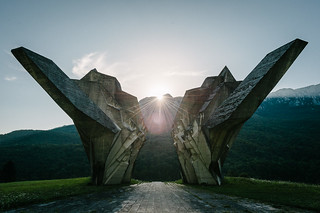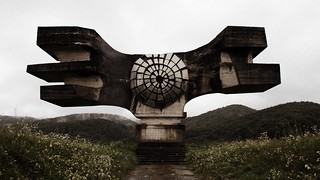Remembering the Spomeniks
- May 28, 2015 - 11:22 pm
- Former Yugoslavia
- Comments Off on Remembering the Spomeniks
By Maryna Polataiko for postcommunistmonuments.ca
They were built in the 60s and 70s. They were later deemed “abandoned.” Yet for something so allegedly antiquated, people cannot seem to forget them. The enduring memory of the Spomeniks is not unbefitting, for their name describes just that: the monuments. Commissioned by Josep Broz Tito in the wake of the Second World War, the series of behemoth structures designed by various sculptors and architects (Miodrag Živković, Dušan Džamonja, Gradimir Medaković, Bogdan Bogdanović et al.) were built to commemorate the lives of soldiers lost in combat. Each monument, evasive of flouting for whom it stands, is positioned on battlegrounds across the former Yugoslavia. Following the victory against German occupation, the Spomenik served as a unifier to a new confederation.
But after the brutal disbanding of Yugoslavia, the concrete alien configurations became ghostly reminders of a failed socialist regime. Having lost their salience in their home countries, the monuments went into a slumber until 2010 when Belgian photographer Jan Kempenaers resurrected them into the international spotlight. Since then, the Yugoslavian monuments have transcended national boundaries and have drawn the attention of artists and scholars alike.
Perhaps most striking is artist Aleksandra Domanović’s appropriation of the spomenik. For the 4th Marrakech Biennale in 2012, Domanović recreated one of the fist monuments from Bubanj Memorial Park in Niš (Serbia), designed by Croatian sculptor Ivan Sabolić in 1963. But the structure is far from a carbon copy. Her version is 6 meters tall, made of wood, and gleaming with bright pink tadelakt—a traditional Moroccan finishing process. Domanović left spectators with a strangely recontextualized monument, melding signifiers of Yugoslavian socialism with a Moroccan environment.
In 2014, the spomeniks were showcased in a video by Croatian artist Igor Grubic at the ‘Concrete’ exhibition at the Monash University Museum of Art (MUMA) in Melbourne (Australia). His work explores memorials as well as historical erasure. Amsterdam-based Serbian artist Kristina Benjocki’s ongoing multimedia project, ‘Past, Less Predictable Than the Future’ explores politics and memory through the Yugoslavian memorials as well. Vladimir Kulić—assistant professor of architectural history and theory at Florida Atlantic University—has received a grant from the Graham Foundation to examine the works of Serbian-Yugoslav architect Bogdan Bogdanović—whose work includes the Jasenovac Memorial Complex, in Jasenovac, Croatia.
This April, the Baltic Centre for Contemporary Art, Newcastle (UK) is holding a seminar on socialist Yugoslavia’s modernist architecture. To say that Tito’s monuments have been forgotten could not be further from the truth.
[SOURCES:]
Yasmin Nurming-Por. “Speaking of Time: The Ethics and Aesthetics of Framing Yugoslavia’s Spomenik Post ’89.” Drain Magazine 11, no. 2 (2014). Accessed April 15, 2015. http://drainmag.com/speaking-of-time-the-ethics-and-aesthetics-of-cultural-mortality-the-politics-of-framing-yugoslavias-spomenik-post-89/.
http://www.averyreview.com/issues/1/partial-recall
Chan, Carson. ‘The Avery Review | Partial Recall: A Brief Account Of Aleksandra Domanović’s Monuments And The Aesthetics Of The Near Obsolete.’ Averyreview.com. N.p., 2015. Accessed April 1, 2015.
Dan Rule. “Concrete Exhibition Explores Monumental Themes.” The Sydney Morning Herald, May 6, 2014. Accessed April 15, 2015. http://www.smh.com.au/entertainment/art-and-design/concrete-exhibition-explores-monumental-themes-20140506-zr5f0.html#ixzz3Wqq3BF5P.
Vladimir Culić. “Architecture’s Expanded Field: Bogdan Bogdonović and the Alternative Genealogy of Postmodernism.” Graham Foundation. Accessed April 15, 2015. http://www.grahamfoundation.org/grantees/5159-architecture-s-expanded-field-bogdan-bogdanovic-and-an-alternative-genealogy-of-postmodernism.



